

Plastic Injection Molding. Museum of Design in Plastics, MoDiP. Processing. How Plastics Work" Plastics are everywhere.
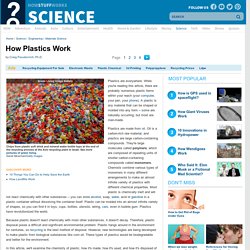
While you're reading this article, there are probably numerous plastic items within your reach (your computer, your pen, your phone). A plastic is any material that can be shaped or molded into any form -- some are naturally occurring, but most are man-made. SPI - About Plastics - Definitions of Resins. PLASTICS have developed an amazing presence in our lives.
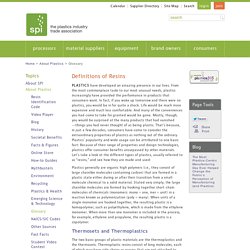
From the most commonplace tasks to our most unusual needs, plastics increasingly have provided the performance in products that consumers want. In fact, if you woke up tomorrow and there were no plastics, you would be in for quite a shock. Life would be much more expensive and much less comfortable. And many of the conveniences you had come to take for granted would be gone. Mostly, though, you would be surprised at the many products that had vanished—things you had never thought of as being plastic.
Plastics generally are organic high polymers (i.e., they consist of large chainlike molecules containing carbon) that are formed in a plastic state either during or after their transition from a small-molecule chemical to a solid material. Thermosets and Thermoplastics The two basic groups of plastic materials are the thermoplastics and the thermosets. How Plastics Are Made. The Basics of Plastic ManufacturingThe Structure of PolymersAdditivesThe Two Plastic Types, Based on ProcessingThermoplastic and Thermoset Processing Methods.

Plastipedia - The Web's Largest Plastics Encyclopedia. Polymerization Process -3D Animation / Polymerisationsprozess. Polymers: an overview. When many molecules of a simple compound join together, the product is termed a polymer and the process polymerization.
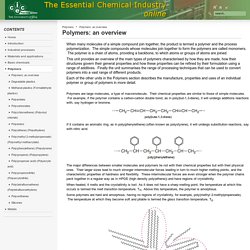
The simple compounds whose molecules join together to form the polymers are called monomers. The polymer is a chain of atoms, providing a backbone, to which atoms or groups of atoms are joined. This unit provides an overview of the main types of polymers characterised by how they are made, how their structures govern their general properties and how these properties can be refined by their formulation using a range of additives. Finally the unit summarises the range of processing techniques that can be used to convert polymers into a vast range of different products. Each of the other units in the Polymers section describes the manufacture, properties and uses of an individual polymer or group of polymers in more detail. What is the Chemistry of the Polymerisation of Ethene? - What is an Addition Polymer? - What is the Repeat Unit?
Gcsescience.com 58 gcsescience.com Products from Oil The Chemistry of the Polymerisation of Ethene.
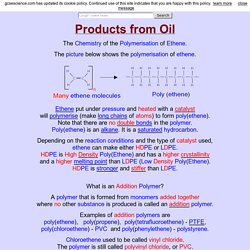
The picture below shows the polymerisation of ethene. Ethene put under pressure and heated with a catalyst will polymerise (make long chains of atoms) to form poly(ethene). How are polymers made? Frank N.
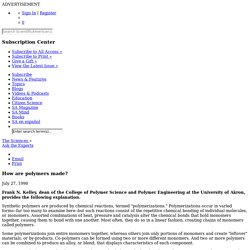
Kelley, dean of the College of Polymer Science and Polymer Engineering at the University of Akron, provides the following explanation. Synthetic polymers are produced by chemical reactions, termed "polymerizations. " Polymer Structure. Polymer Structure Engineering polymers include natural materials such as rubber and synthetic materials such as plastics and elastomers.
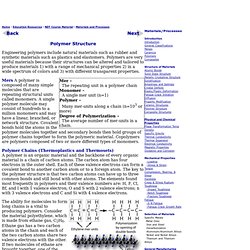
Polymers are very useful materials because their structures can be altered and tailored to produce materials 1) with a range of mechanical properties 2) in a wide spectrum of colors and 3) with different transparent properties. Chapter 15. Polymer Structures. 15.1 Introduction Polymers are common in nature, in the form of wood, rubber, cotton, leather, wood, silk, proteins, enzymes, starches, cellulose.
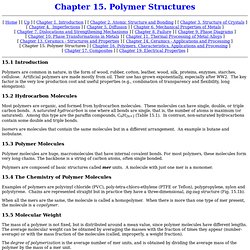
Artificial polymers are made mostly from oil. Their use has grown exponentially, especially after WW2. Atomic Structure. At the very center of each atom is the nucleus (new-klee-us).

The nucleus is a cluster of particles called protons and neutrons. Protons have a plus (+) charge, and neutrons are neutral (that is, they don't have a charge). The nucleus is very compact, and even though it accounts for most of an atom's weight, it takes up a very small amount of the atom's total volume. Weird, huh - it would be like if just about all of your weight was in your belly button. Rubber selection - outline properties for different rubber types. Rubber Selection - A Guide to Outline Properties The information below is intended to give a broad overview of the properties of a number of different rubbers.
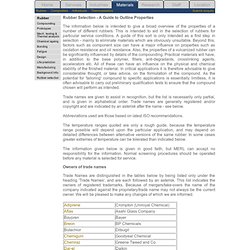
This is intended to aid in the selection of rubbers for particular service conditions. A guide of this sort is only intended as a first step in selection - mainly to eliminate materials which are obviously unsuitable. Beyond this, factors such as component size can have a major influence on properties such as oxidation resistance and oil resistance. Also, the properties of a vulcanized rubber can be significantly influenced by details of the compounding. Trade names are given to assist in recognition, but the list is necessarily only partial, and is given in alphabetical order. Abbreviations used are those based on latest ISO recommendations. The information given below is given in good faith, but MERL can accept no responsibility for the information. Thermoset Plastic. Polymer Classification.
Introduction to Polymers. Polymers are a large class of materials consisting of many small molecules (called monomers ) that can be linked together to form long chains, thus they are known as macromolecules . Kinds of Polymers. New.